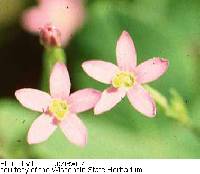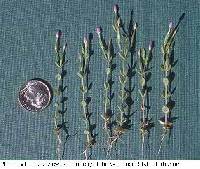|
|
|
|
Family: Gentianaceae
branched centaury
|
Annual herb 5 - 30 cm tall Stem: normally much branched from near the base, and bushy in appearance. Leaves: only along the stems, opposite, stalkless, 1 - 2 cm long, narrow, oblong to lance- or egg-shaped, but always longer than wide. Inflorescence: many-flowered, branched, and comparatively dense with short internodes. Flowers: pinkish, stalked (stalks 2 - 5 mm long), small (about 1 cm tall and 4 - 7 mm wide), radially symmetric, and long tubular with short, spreading lobes. Sepals: four or five, but fused into an about 9 mm long tube, then separating into very narrow lobes, which are less than 1 mm wide. Petals: four or five, but fused into a tube about 1 cm long, then separating into four or five, 2 - 3.5 mm long, somewhat lance-shaped, spreading, pink lobes, which are often whitish at the base. Stamens: four or five, spirally twisted, and extending beyond the petal lobes, with which they alternate. Pistil: with a single-chambered, superior ovary; a single style; and a more or less egg-shaped (not linear), very short stigma, which is less than half the length of the style. Fruit: a single-chambered capsule about 1.5 cm long. Similar species: Centaurium pulchellum is similar to C. erythraea, but that species has basal rosette leaves, its flowers are stalkless, and the petal lobes are longer (to 5 mm). Flowering: June to early October Habitat and ecology: Overall found in waste places, this species is quite common in disturbed limy soils, especially in industrial areas in western Gary (Lake County, Indiana) and the Calumet area in southeast Cook County, Illinois. It is also frequent in the dune areas in Indiana, and occasional in industrial districts throughout the Chicago Region. Occurence in the Chicago region: non-native Etymology: Centaurium comes from the Latin Centaurus, referring to the myth that its medicinal properties were discovered by the Centaur. Pulchellum is the Latin word for beautiful. Author: The Field Museum Annual, much branched, often from the base, to 2 dm, without a rosette; principal lvs sessile, lanceolate or lance-ovate, 1-2 cm; infl many- fld, comparatively dense, with short internodes; pedicels mostly 3-5 mm; cal ca 9 mm; cor-tube slightly exceeding the cal, its lobes pink, 4 mm; anthers oval, under 1 mm, not coiled; 2n=36. Native of Eur., locally intr. in fields and waste places in our range. June-Sept. Gleason, Henry A. & Cronquist, Arthur J. 1991. Manual of vascular plants of northeastern United States and adjacent Canada. lxxv + 910 pp. ©The New York Botanical Garden. All rights reserved. Used by permission. |




